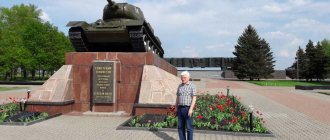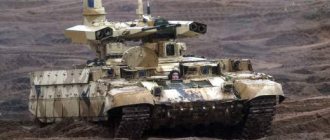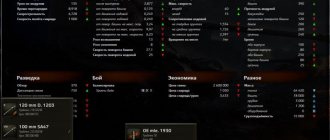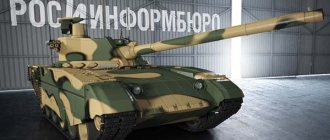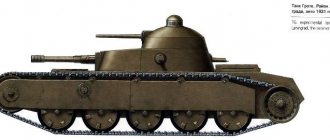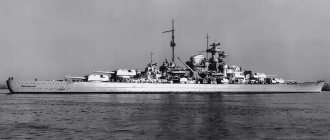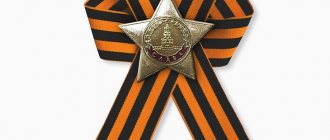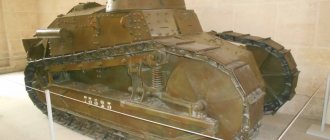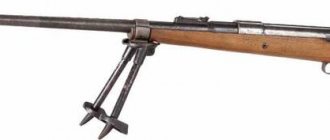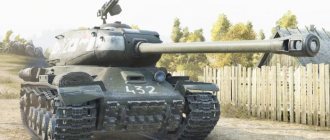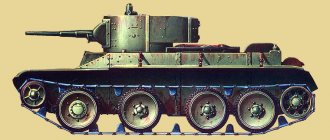For many generations of people born in the era of the USSR, victory in World War II is associated with certain types of military equipment. Il-2 aircraft, the legendary BM-13 Katyusha multiple rocket launchers, the famous T-34 - these and many other combat vehicles became a symbol of the victory of the Soviet people in the bloodiest and largest war in the history of mankind. The history of the Victory of the Soviet Union in the Great Patriotic War gave the T 34 tanks a special and honorable place. Many of them today are frozen on pedestals and pedestals, reminding future generations of their role in achieving victory over an insidious and cruel enemy.
Tank T-34
Monuments to Soviet T-34 tanks can be found in almost any Russian city, across the vast expanses of the country, from the Far East and Kaliningrad. Soviet thirty-fours can be found at monuments and in cities in European countries. Monuments to the Soviet T-34-76 tank are rightfully located in Berlin, the former capital of the defeated Third Reich. It was here that the legendary vehicles took part in the last battles of the Great Patriotic War. The cars can be seen at the memorial to Soviet soldiers in Treptow Park and at the Brandenburg Gate.
T-34 in Berlin
The image of the Soviet tank is the most recognizable in the world. Soviet technology is unmistakably recognizable in America and Japan, Cuba and Africa. The vehicle was tested not only on the battlefields of World War II, but also continued to remain in service for almost 50 years. The last combat use of T-34 tanks, already the latest modification with an 85-mm gun, took place during the events in Yugoslavia in the mid-90s.
A difficult start to a glorious journey
The history of the Soviet T-34 tank is pages written with blood and sweat. Despite the fact that today, in most cases, the idea of a legendary tank is formed on the basis of the T-34-85 vehicle with a long and powerful gun, the vehicle of the very first modification bore the brunt of the battles of the Second World War. It was with this machine that the Red Army entered the Great Patriotic War. Until 1944, the main tank of the Red Army was the T-34-76. Soviet tank crews fought on these tanks in 1941 near Moscow and took part in the bloody battles near Stalingrad in the summer and winter of 1942. The first modification of the “thirty-four” suffered a lot of tests during the battle on the Kursk Bulge in 1943.
Soviet T-34s became the most popular tanks in the entire history of the war. From 1940 to 1947, the car in various modifications was produced in the USSR by 7 factories at once. Later, after the end of World War II, Soviet T-34-85 tanks began to be assembled at factories in Czechoslovakia and Poland. Before the war, the new car was mainly produced by the Stalingrad Tractor Plant, Kharkov Plant No. 75 and the Kirov Plant in Leningrad. Subsequently, with the beginning of the Great Patriotic War, Gorky, Omsk plant No. 174, a tank plant in Nizhny Tagil and plant No. 183 in Chelyabinsk joined the production of “thirty-fours”.
During the first period of the war, from the summer of 1941 to the summer of 1942, the Soviet tank industry experienced the most difficult period associated with the large-scale evacuation of enterprises to the East. New tank factories in Nizhny Tagil, Omsk and Gorky were just gaining the necessary capacity. Old Soviet tank factories in the European part of the country continued to operate in difficult front-line conditions. The Kirov plant in Leningrad continued to produce KV and T-34 tanks during the blockade. The Kharkov plant was lost as a result of the rapid German offensive in the spring of 1942. The Stalingrad Tractor Plant produced T-34 tanks so necessary for the front until the very last moment, when street battles were already taking place in the city.
Despite the difficult conditions at the front and the loss of main production facilities, Soviet troops continued to receive medium tanks.
In general, we can say that 1941 became a landmark year for the T-34 tank. The role of the “thirty-four” in the most difficult and difficult period for the Red Army can hardly be overestimated, even if in the first months of fighting at the front, up to 80% of the new vehicles available to the troops as of June 22, 1941 were lost.
Tank losses
The difficult situation with equipping Soviet troops with modern and combat-ready armored vehicles, which developed in the second half of 1941, inevitably affected the strength of the Red Army's defense. The enemy increased the strength of its attacks, using tank strike formations in the main directions. The Soviet troops could not oppose anything to this onslaught, due to the lack of the necessary number of modern and powerful tanks in the troops.
The Soviet tank industry did not have time to make up for the losses of armored vehicles in the troops; the defense industry in the east of the country was only gaining its capacity. In the battles near Moscow, the Soviet command used mainly old, obsolete light tanks BT-7 and T-26. The situation was slightly eased by the appearance of light tanks T-50 and T-60 at the front in small numbers. The share of modern Soviet tanks of the Second World War T-34 and KV in the troops after the devastating first months of 1941 was insignificant.
Assembly shop
Only a year later, during the counteroffensive of Soviet troops near Stalingrad, the situation began to change for the better. The Soviet shock tank corps were equipped with the new “thirty-fours” in sufficient quantities. Beginning in the spring of 1942, Soviet tank crews began to receive brand new T 34s coming off the assembly lines of Ural factories. Already by the beginning of 1943, the Soviet tank industry in terms of tank production surpassed the results of the work of tank factories in Germany and occupied Europe. Soviet factories produced 15,889 T 34 tanks alone in 1943. Since 1944, production of a more advanced vehicle began, in which the turret was replaced and the main weapon was the 85-mm ZIS-S-53 cannon.
Legendary T-34
This tank is the most recognizable symbol of the Great Patriotic War.
The best tank in its class during World War II. One of the most popular tanks in the world. The vehicle that formed the basis of the armored armies of the USSR that passed through all of Europe. What kind of people led the "thirty-four" into battle? How and where were you taught? What did the battle look like “from the inside” and what was the everyday life of Soviet tank crews like at the front?
Tank crew training up to...
Before the war, a career tank commander trained for two years. He studied all types of tanks that were in the Red Army. He was taught to drive a tank, shoot from its cannon and machine guns, and was given knowledge on tank battle tactics. A general specialist came out of the school. He was not only the commander of a combat vehicle, but also knew how to perform the duties of any crew member.
In the thirties, the military enjoyed enormous popularity in the USSR. Firstly, the Red Army, its soldiers and officers, symbolized the power of the relatively young Soviet state, which in just a few years had transformed from a war-ravaged, impoverished, agrarian country into an industrial power capable of standing up for itself. Secondly, officers were one of the wealthiest segments of the population.
For example, an instructor at an aviation school, in addition to full maintenance (uniforms, lunches in the canteen, transport, dormitory or money for rent), received a very high salary - about 700 rubles (a bottle of vodka cost about two rubles). In addition, service in the army gave people from peasant backgrounds a chance to improve their education and master a new, prestigious specialty.
Alexander Burtsev, a tank commander, says: “I remember that after three years of service they returned from the army as different people. The village idiot left, and a literate, cultured man returned, well dressed, in a tunic, trousers, boots, physically stronger. He could work with equipment and lead. When a serviceman came from the army, as they were called, the whole village gathered. The family was proud that he served in the army, that he became such a person.”
The coming new war - the war of engines - also created new propaganda images. If in the twenties every boy dreamed of checkers and cavalry attacks, then by the end of the thirties this romantic image was forever supplanted by fighter pilots and tank crews. Piloting a fighter plane or shooting an enemy from a tank cannon – this is what thousands of Soviet boys now dreamed of. “Guys, let’s join the tank crews! It's an honor! You go, the whole country is under you! And you are on an iron horse!” – phrases describing the mood of those years, recalls the platoon commander, Lieutenant Nikolai Yakovlevich Zheleznov.
...and during the war
However, during the severe defeats of 1941, the Red Army lost almost all the tanks it had in the western districts. Most of the regular tank crews also died. The acute shortage of tank crews became obvious already in the summer of 1942, when the industry evacuated to the Urals began producing tanks in the same volumes.
The country's leadership, realizing that tankers would play a decisive role in the 1943 campaign, ordered the fronts to send at least 5,000 of the best privates and sergeants with at least seven classes of education to tank schools every month. Every month, 8,000 of the best soldiers with at least three classes of education were recalled from the front to the training tank regiments, where rank and file personnel were trained - gunners-radio operators, driver-mechanics and loaders. In addition to front-line soldiers, yesterday’s high school graduates, tractor drivers and combine operators sat on the school bench.
The course of study was shortened to six months, and the program was cut to the minimum. But I still had to study 12 hours a day. We mainly studied the material parts of the T-34 tank - chassis, transmission, cannon and machine guns, radio station.
All this, as well as the ability to repair a tank, was learned both in classes and in practical exercises. But there was a catastrophic lack of time. Platoon commander Vasily Bryukhov recalls: “After graduating from college, I fired three shells and a machine-gun disc. Is this preparation? They taught us a little driving on the BT-5. They taught us the basics - to get moving, to drive in a straight line. There were classes in tactics, but mostly “on foot like a tank.” And only at the end there was a show of “tank platoon on the offensive.” All! Our preparation was very poor. When we were released, the head of the school said: “Well, sons, we understand that you quickly skipped through the program. You don’t have any solid knowledge, but you’ll learn in battle.”
From school to the front
Freshly promoted lieutenants were sent to tank factories in Gorky, Nizhny Tagil, Chelyabinsk and Omsk. A battalion of T-34 tanks rolled off the assembly lines of each of these factories every day. The young commander filled out the tank acceptance form. After this, he received a penknife, a silk scarf for filtering fuel, a revolver and a tank watch the size of a fist, which was installed on the dashboard. However, tankers often carried them with them. Not everyone had a wristwatch or pocket watch at that time. Ordinary crew members were trained in three-month courses in reserve tank regiments located at the factories. The commander quickly got acquainted with the crew and made a fifty-kilometer march, which ended with live firing.
After this, the tanks were loaded onto platforms, and the train rushed them west - towards their fate.
Inside the T-34
The legendary medium tank, which entered service in 1940, was in many ways a revolutionary design. But, like any transitional model, it combined novelties and forced decisions. The first tanks had an outdated gearbox. The noise in the tank was incredible, and the tank intercom worked disgustingly. Therefore, the tank commander simply put his feet on the driver’s shoulders and controlled him using predetermined signals.
The T-34 turret was only for two. Therefore, the tank commander performed the duties of both commander and gunner. By the way, the commander and the loader were somehow able to talk, but most often their communication also took place through gestures. The commander put his fist under the loader’s nose, and he already knows that he needs to load with armor-piercing, and his outstretched palm with fragmentation.
Gunner-radio operator Pyotr Kirichenko recalls: “Shifting gears required enormous effort. The driver moves the lever to the desired position and begins to pull it, and I pick it up and pull it along with him. The transmission will shake for a while and only then turn on. The entire tank march consisted of such exercises. During the long march, the driver lost two or three kilograms in weight: he was all exhausted. In addition, since his hands were busy, I took the paper, poured samosad or shag into it, sealed it, lit it and inserted it into his mouth. This was also my responsibility."
Battle on the T-34 (reconstruction)
There are a few minutes left before the attack begins. The commander’s hands begin to shake, his teeth chatter: “How will the battle turn out? What's behind the hill? What strength do the Germans have? Will I live until evening? The radio operator gunner is nervously gnawing on a piece of sugar - he always craves food before an attack. The loader smokes, inhaling deeply. The cigarette in his hand is shaking. But the signal to attack sounds in the headphones of the commander’s tank helmet. The commander switches to the intercom, but the noise is so loud that nothing can be heard. Therefore, he simply lightly hits the driver, who is sitting directly below him, with his boot on the head - this is the conditioned signal “Forward!” The car, its engine roaring and its tracks clanking, starts moving. The commander looks through the periscope - the entire battalion has moved to attack.
The fear is gone. All that was left was cold calculation.
A mechanic drives a car at a speed of 25-30 kilometers - in a zigzag, changing direction every 50 meters. The life of the crew depends on his experience. It is the mechanic who must correctly assess the terrain, find cover, and not expose the side to enemy guns. The radio operator set up the radio for reception. He has a machine gun, but he can only aim through a hole the diameter of an index finger, in which the earth and sky flash alternately - such shooting will only scare the Krauts, it has little real use. The loader in the panorama observes the right sector. His task is not only to throw shells into the breech, but also to indicate to the commander the targets on the right along the tank’s course of movement.
The commander looks forward and to the left, looking for targets. The right shoulder rested against the breech of the gun, the left against the armor of the turret. Closely. The hands are folded crosswise: the left one is on the gun lifting mechanism, the right one is on the turret rotation handle. So he caught an enemy tank in the panorama. He kicked the driver in the back - “Stop!” and just in case, he shouted into the intercom: “Short!” To the loader: “Armour-piercing!” The driver selects a flat area of terrain, stops the car, and shouts: “Path!” The loader delivers the projectile. Trying to shout out the roar of the engine and the clang of the shutter, he reports: “Armor-piercing is ready!” The tank, having stopped abruptly, sways for some time. Now everything depends on the commander, on his skills and simply on luck. A stationary tank is a tasty target for the enemy! My back was wet from tension. The right hand rotates the rotating mechanism of the turret, aligning the aiming mark with the target in the direction. The left hand turns the gun lifting mechanism, aligning the range mark.
"Shot!" – the commander shouts and presses the gun release pedal. His voice is drowned in the roar of the shot and the clang of the shutter. The fighting compartment is filled with powder gases that corrode the eyes. The fan installed in the turret does not have time to blow them out of the tank. The loader grabs the hot, smoking cartridge and throws it out through the hatch. Without waiting for a command, the mechanic takes the car off the road.
The enemy manages to fire back. But the shell only ricochets, leaving a groove on the armor, like a hot spoon in oil. The impact on the tank makes my ears ring. The scale flying off the armor sticks into your face and grits your teeth. But the battle continues!
T-34 against the "Tigers"
The T-34 was superior to German medium tanks in all respects. It was a maneuverable and fast medium tank, equipped with a long-barreled 76 mm cannon and a diesel engine. A special source of pride for the tankers was the distinctive feature of the “thirty-four” – sloping armor. The effectiveness of inclined armor was also confirmed by combat practice. Most German anti-tank and tank guns of 1941-42 did not penetrate the front armor of the T-34 tank. By 1943, the T-34 had become the main combat vehicle of the Soviet tank armies, replacing the obsolete T-26 and BT.
However, by 1943, the Germans created and modernized the old T-IV medium tanks and began producing heavy tanks TV "Panther" and T-VI "Tiger". The long-barreled guns of 75 and 88 mm caliber installed on the new vehicles could hit the T-34 at a distance of 1.5-2 thousand meters, while the 76 mm gun of our medium tank could hit the Tiger only from 500 m, and the Panther from 800 meters. Using the T-34's advantage in maneuverability and tactical tricks, our tankers often emerged victorious in battles with a technically superior enemy. But it also happened the other way around...
If the tank is hit...
It’s good that if a shell hit the engine compartment, the tank simply stalled and the crew had time to jump out. If the shell pierced the armor of the turret or the side of the fighting compartment, then the armor fragments most often wounded one of the crew members. The spilled fuel flared up - and the tankers had all their hope only in themselves, in their reaction, strength, dexterity, because everyone had only two or three seconds left to escape.
It was even worse for those whose tank was simply immobilized, but not on fire. Ion Degen, a tanker, says: “In battle, there was no need for the commander’s order to leave the burning tank, especially since the commander could have already been killed. They jumped out of the tank intuitively. But, for example, you couldn’t leave the tank if your track was broken. The crew was obliged to fire from the spot until they were hit.”
And it also happened that a tank driver was prevented from leaving a burning car by some small thing, sometimes even by uncomfortable clothing. Tanker Konstantin Shits recalls: “Our commander of one of the companies was Senior Lieutenant Sirik, such a prominent man. Once they captured rich trophies at the station, and he began to wear a good, long Romanian coat, but when they were hit, the crew managed to jump out, and because of this coat he hesitated and burned ... "
But when they were lucky, the tankers jumped out of the burning tank, crawled into the craters and immediately tried to move to the rear. Having survived the battle, the “horseless” tankers entered the battalion reserve. But I couldn’t rest for long. Repairmen quickly restored the unburned tanks. In addition, factories constantly replenished units with new equipment. So literally two or three days later the tanker was included in a new, unfamiliar crew and they went into battle again on a new tank.
It's always harder for commanders
It was even harder for company and battalion commanders. They fought until the last tank of their formation. This means that commanders transferred from one damaged vehicle to a new one several times during one operation, or even one day.
Tank brigades were “reduced to zero” in two to three weeks of offensive battles. After that, they were taken away for reorganization. There, the tankers first of all put the remaining equipment in order and only then themselves. The crew, regardless of rank, refueled the vehicle, loaded it with ammunition, cleaned the gun and aligned the sight, and checked the equipment and mechanisms of the tank.
The loader cleaned the shells of grease - washed them in diesel fuel, and then wiped them dry with a rag. The driver adjusted the tank's mechanisms and poured fuel, oil and water into buckets. The gunner-radio operator and the commander helped them - no one disdained dirty work. The fate of the tank depended on the crew, but the life of the crew was also directly related to the condition and combat effectiveness of the tank.
We have prepared the car for the upcoming battle or march - now you can wash, shave, eat and, most importantly, sleep. After all, the tank was not only a fighting vehicle for the crew, but often also a home.
Life of tankers
A tank tarpaulin measuring 10 by 10 meters was tied to the tank turret. The crew covered the tank with it on the way to the front. Simple food was laid out on it. The same tarpaulin served as a roof over the tank crews’ heads when it was not possible to stay overnight in houses.
In winter conditions the tank froze and became a real “refrigerator”. Then the crew dug a trench and drove a tank on top of it. A “tank stove” was suspended under the bottom of the tank, which was heated with wood. It was not very comfortable in such a dugout, but it was much warmer than in the tank itself or on the street.
The habitability and comfort of the “thirty-fours” themselves were at the minimum required level. The seats of the tankers were made rigid and, unlike American tanks, they had no armrests. However, tankers sometimes had to sleep right in the tank - half-sitting. Senior Sergeant Pyotr Kirichenko, gunner-radio operator of the T-34, recalls: “Although I was long and thin, I still learned to sleep in my seat. I even liked it: you recline your back, lower your boots so that your feet don’t freeze on the armor, and sleep. And after the march it’s good to sleep on a warm transmission, covered with a tarpaulin.”
The tankers lived like Spartans under duress. During the offensive, they did not even have the opportunity to wash or change clothes. Tank driver Grigory Shishkin says: “Sometimes you don’t wash for a whole month. But sometimes it’s normal to wash once every 10 days. They did the bathhouse like this. They built a hut in the forest and covered it with spruce branches. There is also spruce branches on the floor. Several crews gathered. One drowns, another chops wood, the third carries water.”
During periods of intense fighting, even food was often delivered to tankers only at the end of the day - breakfast, lunch, and dinner at once. But at the same time, the tankers were supplied with dry rations. In addition, the crew never neglected the opportunity to carry food supplies in the tank. During the offensive, this supply became practically the only source of food, which was replenished from trophies or thanks to the help of civilians. “Tank crews have always had good supplies. And, of course, food trophies were an additional ration for us... And tank NZ was always eaten before the battles - what if we burn out, so why should the goodness disappear? – says tanker Mikhail Shister.
In the evening after the battle, you could drink “People’s Commissar’s hundred grams.” But before a battle, a good commander always prohibited alcohol for his crew. Crew commander Grigory Shishkin about this feature of the tankers: “The main thing is that everyone around them drinks. The sappers begin: “Hey, you black-bellied ones, what aren’t they giving you?!” At first the guys were offended, but then they realized that I was trying for them. After the fight, drink as much as you want, but before the fight, under no circumstances! Because every minute, every second counts. If you made a mistake, you’ll die!”
We rested, lost the fatigue of past battles - and now, the tankers are ready for new battles with the enemy! And how many more of these fights were ahead on the way to Berlin...
Introducing the enemy to new Soviet tanks
The German troops, who first encountered new Soviet vehicles, T-34 and KV tanks on the battlefield, were unpleasantly surprised. In the absence of effective anti-tank weapons from the enemy, the Soviet T-34s and KVs were practically invulnerable to enemy fire. German 37 mm Pak anti-tank guns. 35/36 could not penetrate the armor of Soviet tanks. Only in those sections of the Soviet-German front where the Germans had more powerful 5 cm Pak 38 and captured French guns could Soviet tanks be stopped.
The Germans were losing significantly in the tank confrontation. The main opponents of Soviet vehicles were German medium tanks, Pz III and Pz IV - vehicles with which the Wehrmacht traveled throughout Europe. German vehicles were inferior to the T-34 in firepower and armor thickness. The Soviet L-11 and F-34 cannons, which were equipped with the T-34, penetrated the armor of German medium tanks at all combat distances. In terms of range, armor and firepower, Soviet vehicles were significantly superior to their German counterparts.
Opponents of the T-34
Until the summer of 1943, there was no worthy opponent on the battlefield in the German Panzerwaffe. German tank divisions could successfully resist Soviet tanks only through close cooperation with front-line aviation and motorized infantry. Outflanking maneuvers, surprise attacks and breakthroughs were the main tools of the German offensive strategy. In direct contact with Soviet medium tanks, the Germans lost. Only thanks to the coordinated actions of German aviation, artillery and infantry, the Germans managed to establish an effective anti-tank defense system. The Germans were able to achieve success on the battlefield in clashes with Soviet tanks due to the combat experience and skill of German tank crews, skillful command and control of troops and better tactical training.
The reason for the subsequent modernization of the Soviet “thirty-four” was the appearance at the front at the end of 1942 of the modernized Pz IV medium tank, armed with a 75-mm long-barreled gun. The subsequent appearance on the Soviet-German front in the summer of 1943 of new models of German armored vehicles radically changed the balance of forces. The new German tanks, the medium tank Pz V "Panther" and Pz VI "Tiger", which entered service with the Wehrmacht, were superior to the Soviet T-34-76 in all respects. Soviet tankers on the T 34 could not effectively fight armored monsters on the battlefield and suffered heavy losses.
The results of tank battles between German shock tank formations and Soviet tank armies near Kursk only confirmed the Soviet military leadership in the need for urgent modernization of the Soviet main tank. Soviet T-34-76 tanks are living monuments to the tank power of the Red Army, which was demonstrated to German troops on all sectors of the Soviet-German front in 1942 and in the first half of 1943.
Near Kursk
The birth of the T-34 tank. Overview and structure of the machine
A review of the events and facts that accompanied the birth of the T-34 tank is filled with drama. Soviet designers, led by M.I. Koshkin, managed to create a machine that was ahead of its time in many respects. Since 1939, the design bureau has been actively working on the creation of a new type of tank. The result of the fruitful work of Kharkov design engineers were two prototypes of the T-34№1 and T-34№2 tanks. In March 1940, both vehicles were to be tested at the Kubinka tank training ground. For this purpose, M.I. Koshkin managed to organize the run of experimental vehicles along the route Kharkov - Moscow. The run was planned as a necessary march, which experimental vehicles must have before the start of military tests.
Experimental machines
Both cars, having traveled 750 km from Kharkov to Moscow under their own power, would have gained the missing kilometers. The turrets on the experimental T-34 tanks were unarmed. The final decision on arming the new equipment should have been made based on the results of sea trials.
Leaving Kharkov on the night of March 6, two prototypes arrived in Moscow on March 12. Many books, essays and films are devoted to reviewing the legendary run of the first two prototypes of the T-34 tanks. A detailed description of the events that surrounded the run of prototypes to Moscow and subsequent military tests can be obtained by visiting the “History of the T-34 Tank” museum-monument. This memorial complex is located 37 km west of Moscow along Dmitrovskoye Highway.
T-34 and Koshkin
It is better to review experimental machines by starting with its predecessors. The latest BT-7M tanks had a diesel engine. It was this aspect that became key for Mikhail Ilyich Koshkin, who relied on the high specific power of the engine. Another aspect that deserves attention is the rational angles of inclination of the armor plates. These qualities were transferred to the experimental T-34 vehicle from the A-30 and A-32 tanks. The armor of the T-34 tank was located in the frontal part and on the sides at angles of 60° and 45°. This tilt made it possible to increase the resistance of the armor when hit by a projectile by exactly 2 times.
In service
For reference: The Germans used a similar armor arrangement only in 1942, in the process of creating the new PZV “Panther” tank.
The turret of the T-34 tank had a hexagonal shape, while the armor plates were also located at an angle of 30°. This form of tower was considered very convenient. All armor plates had welded joints, which reduced the cost of the vehicle and speeded up the process of assembling the vehicle in the factory.
Engines
The new V-2 diesel engine with a power of 500 l/s provided Koshkin’s vehicle with excellent maneuverability, mobility and power efficiency. During tests at the Kubinka training ground, military experts were captivated by the simplicity of the design of the T-34 tank. In the form in which the tank was presented to the state commission, one could talk about the possibility of quickly organizing mass production of vehicles using existing domestic facilities. The main components and assemblies of armored vehicles could be adjusted and repaired in the field. The chassis had five road wheels, and the T-34 track tracks were smooth, without lugs, which significantly increased the vehicle's performance and speed.
T-34 measurements
The tank's armament is also interesting. The new vehicle was created based on technical specifications, in which the emphasis was on equipping the new tank with a powerful 76-mm L-11 cannon. A gun of this caliber was superior in power to all existing tank guns equipped on German, British and French tanks. The first vehicles were equipped with the L-11 cannon. Beginning in 1941, new T-34s were equipped with the 76 mm F-34 gun. The gun was served by the tank commander, who served as a gunner, and a loader. The crew of the T-34-76 tank was supplemented by a driver-mechanic and a gunner-radio operator.
Driver's seat
The main combat and tactical-technical characteristics of the vehicle with which the Red Army entered the Great Patriotic War are as follows:
- The combat weight of the 1940 vehicles is 26.3 tons;
- The combat weight of the 1941 model tank is 28 tons;
- Engine power – 500 l/s;
- Highway speed (rough terrain) 54 (36) km/h;
- Highway range (rough terrain) 390 (230) km;
- Main armament: T-34 manufactured in 1940, L-11 cannon with 76 mm caliber, 2 machine guns with 7.62 mm caliber;
- T-34-76 manufactured in 1941, F-34 cannon with 76 mm caliber, 2 7.62 mm machine guns.
T-34-76
Device T-34-85“The T-34-85 medium tank is a tracked combat vehicle with a rotating turret that provides all-round fire from a cannon and a coaxial machine gun” (“Manual on the material and operation of the T-34 tank”).
The T-34 tank is designed in accordance with the so-called classic layout, that is, the fighting compartment with a turret in front, the engine-transmission compartment with drive wheels in the rear. This arrangement was first used on the French Renault tank in 1917, but perhaps it was most clearly embodied in the BT and T-34 series tanks. The latter, to a certain extent, inherited from the BT the general layout, chassis and suspension parts.
The main parts of the tank are: hull and turret, weapons, power plant, power train (transmission), chassis, electrical equipment and communications. The tank hull is welded from rolled armor plates. Only the upper stern plate was bolted to the corners of the side and lower stern armor plates and, with the bolts removed, could be folded back on two hinges, thereby providing access to the power plant. The roof over the power plant is also removable. In the upper frontal plate of the hull, installed at an angle of 60° to the vertical, there is a driver's hatch on the left and a machine gun ball mount on the right. The upper side plates of the hull are installed with an inclination of 41°. The lower side sheets are vertical. Each has 4 holes for the passage of the balancer axes of the track rollers, one hole for the bracket for the balancer axes of the front track roller and 4 cutouts for the trunnion of the balancers of the second to fifth rollers.
The bottom of the body consists of two or four (depending on factory differences) sheets, butt welded with overlays. On the front right in the bottom in front of the machine gunner's seat there is an emergency exit hatch through which the crew can leave the vehicle in an emergency. There are also hatches and hatches cut into the bottom for draining fuel from the onboard tanks, draining oil from the engine and gearbox, etc.
Inside the tank body has 4 compartments. In front is the control compartment, which houses the driver and machine gunner, levers and pedals of control drives, and instrumentation. Behind the control compartment is the fighting compartment with a turret, which houses the remaining crew members - the commander, gunner and loader. A removable steel partition separates the fighting compartment from the power unit compartment (PS), in the middle of which the engine is installed on a pedestal. On the sides of the engine there are water radiators, two oil tanks and four batteries. There is a hatch cut out in the roof above the control unit with an armored cover for access to the engine, and on its sides there are elongated air inlets covered with armored shutters.
In the stern, behind the partition, there is a power transmission compartment, which houses the main clutch, clutch, final clutches with brakes and final drives, as well as an electric starter, two fuel tanks and two air cleaners. In the roof above the power transmission compartment there is a rectangular air vent, closed with a metal mesh, under which there are adjustable armored blinds. The upper stern plate is equipped with a round hatch with an armored cover, hinged, usually bolted to the armor plate flange. The same sheet contains two armored caps covering the exhaust pipes, as well as two brackets for attaching smoke bombs.
The main armament of the tank was initially a 76-mm semi-automatic L-11 cannon of the 1939 model with a vertical wedge breech. In 1941, it was replaced by guns of the same caliber F-32 and F-34 model 1940. Later, the T-34-85 received an 85-mm gun, first the D-5T model, and then the ZIS-S-53. Thanks to the rotation of the turret , the cannon and coaxial machine gun had all-round fire. In the vertical plane, the elevation angle of the cannon and machine gun is 22°. At a descent angle of 5°, the unhittable (dead) space on the ground for the cannon and coaxial machine gun is 23 m. The height of the gun's line of fire is 202 cm. The frontal machine gun had a horizontal firing angle of 12° to the left and right, a descent angle of 6° (dead space 13 m ), elevation angle 16°. An experienced crew, when firing from a standstill, is able to fire 7-8 aimed shots from a cannon per minute. Using the TSh-16 telescopic sight, it was possible to fire direct fire at a distance of up to 3800 m, and with the help of a side level and a goniometer circle, indirect fire (for example, from closed positions) at a distance of 13600 m. Direct fire range at a target height of 2 m with armor-piercing the projectile is 900 m. The rotation of the turret is carried out by a rotation mechanism with manual and electric drive. It is located to the left of the cannon on the wall of the tower. The maximum rotation speed of the tower from the electric motor is 25-30 g/sec. When operated manually, the turret rotates 0.9° per turn of the flywheel. Vertical aiming is carried out manually using a sector lifting mechanism, which is also located to the left of the gun. The cannon can be fired using a mechanical or electric trigger.
Layout of the T-34-85 tank
Chassis typical of the T-34 produced in 1942-43. with a combination of support rollers with and without rubber.
Front track roller suspension assembly
Layout of fuel tanks in the T-34. The front four tanks were located in the fighting compartment.
Installation of the ZIS-S-53 gun in the T-34-85 turret
T-34 tracks - regular (left) and widened.
Additional lugs
Externally, the T-34-85 turrets differed not only in shape, but also in the molding seam line, as on this rather rare turret, where the seam line is straight and runs almost along the middle of the turret.
This late-production T-34-85 turret has a noticeable sloped casting seam. Fan fungi are spread throughout the tower.
This type of T-34-85 turret was distinguished by a rough surface shape - the result of a different casting technology. The rollers are already from the T-54 tank.
Interior view of the turret of the T-34-85 tank
1 – loader’s seat, 2 – gunner’s seat, 3 – turret rotation mechanism, 4 – turret ring, 5 – embrasure for firing from personal weapons, 6 – button for turning on the protractor backlight, 7 – turret equipment panel, 8 – MK-4 observation device , 9 – TSh-16 sight, 10 – sight lighting shield, 11 – gun, 12 – turret lighting lamp, 13 – DTM machine gun, 14 – machine gun disc magazine, 15 – turret travel position stopper.
The gun's ammunition consists of 55-60 unitary shots, depending on the production series of the vehicles. For 60 shots, there were usually 39 with a high-explosive fragmentation grenade, 15 with armor-piercing tracer and 6 with sub-caliber shells. The ammunition is placed as follows: the main stowage of 16 (in some vehicles - 12) shots is located in the rear niche of the turret and on the racks. On the right side of the turret there are 4 shots in clamps, and 5 on the walls of the fighting compartment, standing up. The remaining shots are stored in six boxes located on the bottom of the fighting compartment. The machine guns had 31 magazines of 63 rounds each. In addition to the main ammunition, tankers often took ammunition in boxes. The tankers' armament was supplemented by pistols, PPSh and 20 F-1 grenades.
There are 3 MK-4 mirror periscopic observation devices installed on the roof of the turret: at the commander (on the non-retractable part of the roof of the commander's cupola), gunner and loader. This device, developed by the Polish captain R. Gundlyach, was adopted under the mentioned designation in the British army at the beginning of the war. It allows observation both forward and backward without changing the position of the observer's head, but only by moving the prism. The device is mounted and rotated in a cage protected by an armored cap. It can also swing around a horizontal axis, which allows you to increase the vertical viewing angle. The commander's cupola was cast and had a rotating roof on ball bearings with a hinged hatch. There are 5 horizontal viewing slots cut into the walls of the turret, protected by glass blocks. The tower itself is also cast, hexagonal in plan with inclined side walls. In its front wall there is an embrasure cut out for installing a cannon, covered with swinging armor.
View of the driver's and radio operator's seat (T-34-76). On the T-34-85, the radio station moved to the turret, and its place was taken by machine-gun discs and shell stowage (see figure below)
View of the control compartment of the T-34-85 tank
I – machine gunner’s seat, 2 – stowage of machine gun discs, 3 – spare hatch, 4 – rocker, 5 – pedal and fuel handle, 6 – brake pedal, 7 – brake pedal lock, 8 – main clutch pedal, 9 – mechanic’s seat- driver, 10 – fire extinguisher, 11 – air distribution valve, 12 – syringe pump, 13 – air valve, 14 – electrical instrument panel, 15 – valve-reducer, 16 – relay regulator, 17 – hatch cover balancing mechanism, 18 – starter button , 19 – tachometer, 20 – speedometer, 21 – control levers, 22 – manual air pump, 23 – compressed air cylinders, 24 – control panel, 25 – TPU device, 26 – ball mounting of the frontal machine gun.
There are seven holes in the turret roof: on the right is a round hatch for landing the loader, two ventilation holes (on some vehicles - one) covered with armored caps, a cutout for the antenna socket, a hatch for the commander's cupola and two hatches for the periscope heads of the gun commander and the loader.
A power transmission (PT) is a set of units designed to transmit torque from the engine crankshaft to the drive wheels to change the speed of the tank and traction forces over a larger range than the engine allows. The main clutch (MF) smoothly transfers the load to the engine when the tank starts moving, with sudden changes in the number of revolutions of the engine crankshaft and the speed of the tank. It also disconnects the engine from the gearbox when changing gears. GF is a multi-disk (11 driving and driven disks each) engaging dry friction clutch of steel on steel. The GF is turned on or off by the control drive, for which the driver needs to apply a force of up to 25 kg on the levers.
View from the turret side of the power compartment of the T-34-76
T-34 transmission – the starter, control rods, and tanks are clearly visible.
Dismantling the transmission on the T-34-85
The GF is connected to the gearbox by a gear coupling. It is designed to change the traction force on the drive wheels and change the speed of movement, as well as to move in reverse at a constant number of revolutions and a constant direction of rotation of the engine crankshaft and, finally, to disconnect the engine from the joint venture when starting it and idling. The gearbox is mechanical, three-chord, five-speed, has five forward gears and one reverse gear. Gears are switched by a control drive consisting of a rocker link, longitudinal rods and vertical rollers with levers. In order for the tank to turn, it is necessary to brake the track towards which the turn is being made. To disconnect the driving wheels of the tracks from the main shaft of the gearbox, dry friction side clutches (BF) are used (also steel on steel), having from 17 to 21 driving and from 18 to 22 driven disks, depending on the thickness. BFs are installed at the ends of the gearbox main shaft. Switching off is carried out by a drive from the control compartment, for which the driver needs to apply a force of up to 20 kg to the handle of the corresponding lever. Floating band brakes are installed on the driven drums of the BF. They are also driven by drives from the control compartment, for which there are left and right control levers on the sides of the driver's seat. Foot drives are also connected to the brakes for simultaneous tightening of both brake bands without turning off the brake fan. Before this, however, the GF is turned off or the gearbox is switched to the neutral position. And finally, between the final clutches and the drive wheels there are final drives, consisting of a pair of spur gears. Gearboxes increase the traction force on the drive wheels, allowing you to reduce the speed of rotation of the drive wheel and thereby increase the torque on it. In fact, the final drive is a single-stage reduction gearbox.
The chassis of the tank includes the tracked propulsion system and suspension. It is this propulsion unit that provides the tank with high cross-country ability. It consists of two caterpillar chains, two drive wheels, two idler wheels and 10 road wheels. The caterpillar chain is fine-linked, consists of 72 tracks, half of which have guide ridges, the track pitch is 172, and the width is 500 mm. The tracks are connected with fingers through eyelets. One such caterpillar weighs 1070 kg. Double-disc drive wheels (cast or with stamped disks) are installed on the driven shafts of the final drives and are used to rewind the caterpillar. Between the disks on the axles there are 6 rollers, which drag the ridges of the tracks, and, consequently, the entire caterpillar. Cast front idler wheels serve not only to guide the track, but also to tension it. Tension is carried out by moving the guide wheel on the crank. The fact is that with use, the total length of the caterpillar increases. The guide wheel serves to ensure its constant tension. In case of significant wear of the caterpillar, it is allowed to reduce the number of tracks in it by two.
Main electrical equipment and communications T-34-85
The suspension of the T-34 tank is independent with coil springs, and the suspension of the front roller - a double spring - is located vertically inside the bow of the hull and is protected by shields. The suspensions of the remaining rollers are located obliquely inside the tank hull in special shafts. The track rollers are mounted on bearings on axles pressed into the balancers. Double roller with rubber tire. Between the disks of the rollers are the ridges of the tracks. During the production of the T-34, several types of road wheels with external rubber were used. Since the spring of 1942, in order to save scarce rubber, rollers with internal shock absorption were used (however, this did not last long). The rubber shock absorber was placed on bearings on the balancer axles. The savings, however, were “false” - the internal shock absorbers very quickly failed.
The tank's electrical equipment included sources and consumers of electricity. The latter include: an electric starter, an electric motor for turning the turret, fans, an electric trigger for a cannon and a coaxial machine gun, electric motors for a heater (installed after the war) and an oil pump, lighting and alarm devices, a sight heater, a radio station, a tank intercom, etc. The sources of electricity are: a DC generator mounted to the right of the engine, and four batteries installed in pairs on both sides of the engine. The total battery voltage is 24 V, the same voltage is provided by the generator. Its power is 1000 W.
The 9RS radio station is designed for two-way radio communication between tanks or other objects. The station is a telephone and telegraph station, its range depends on the time of day and time of year. It is greatest when using a telephone on a four-meter whip antenna during the winter day: 15 km while moving and up to 20 km when parked. At night, especially in summer, the level of interference increases and the communication range drops to 7 and 9 km, respectively. When working with telegraph, the range increases by 1.5-2 times. When using a shortened antenna, it is naturally smaller. The 9RS radio station works for transmission only by telephone, and for reception by telephone and telegraph. The transceiver with power supply is attached with brackets to the left and rear sheets of the turret to the left and behind the commander’s seat. Since 1952, during a major overhaul, instead of the 9PC radio station, the 10RT-26E radio station was installed, which also works as a telegraph for transmission.
The TPU-Z-BIS-F tank intercom (since 1952 replaced by the TPU-47) consisted of three devices - for the gunner, tank commander and driver.
It is intended for communication between them, and for the commander and gunner through a radio station and with external correspondents.
Two manual carbon dioxide fire extinguishers are mounted inside the tank. A set of spare parts, tools and accessories are located both inside and outside. This includes a tarpaulin, a tow rope, a box with gun spare parts, two spare tracks each - with and without a comb, track track fingers, entrenching tools, etc. After the war, two BDSh smoke bombs were installed at the rear of the tank.
A few words about the work of the crew members. The driver sits on a height-adjustable seat. In front of it in the upper frontal plate there is a hatch closed by an armored cover. The lid contains two fixed periscopes. In order to have a larger horizontal viewing angle, the periscope prisms are located at an angle to the longitudinal axis of the tank. The bottom of the prism is covered with protective glass - thanks to it, fragments of a damaged prism will not injure the driver’s eyes. After the war, soft forehead protectors were placed above the protective glass and on the inner surface of the armor above the periscopes, protecting the driver’s head from bruises.
Installation of a DT machine gun in the front hull plate
In front of the driver there are the following mechanisms and instruments: left and right control levers, to the right of the right lever is the gearbox rocker, a little to the left, below is the manual fuel supply handle. Further to the left there is a fuel pedal, a brake pedal with a latch. Under the driver's left foot is the GF pedal. On the inside of the frontal armor plate below the hatch there is a panel with control devices. And even lower are two compressed air cylinders for air starting the engine. On the left side wall there is an electrical instrument panel, a starter button, a tachometer (shows engine speed) and a speedometer. Below them is a fire extinguisher, etc.
To the right of the driver is a machine gunner. He fires from a front-mounted machine gun of the DT brand (changed to the DTM after the war). The machine gun is inserted into a ball, which is mounted in a special socket in the upper frontal plate of the hull. The machine gunner uses the PPU-X-T telescopic sight. Firing is carried out in short bursts (2-7 shots) at a distance of 600-800 m only at group live targets. The machine gun is automatic using the energy of exhaust powder gases. To prevent gas contamination inside the tank, the machine gun is installed so that the hole of the gas piston is moved outside under the movable armor shield. The machine gun has no stock. Shooting is carried out by pressing the trigger.
In the turret to the left of the gun there is a height-adjustable gunner's seat. The gunner’s task is quite specific: having received target designation from the commander or choosing a target independently, ensure that the cannon and coaxial machine gun are aimed at the target, and fire a shot using either the trigger mechanism or the electric trigger. He has at his disposal a TSh-16 periscope sight with fourfold magnification and a field of view of 16°. The sight also serves to determine the distance to the target and monitor the battlefield. In the field of view of the sight there are four distance scales (for different types of cannon shells and for a coaxial machine gun) and a lateral correction scale. The latter is used for aiming at a frontally moving target. To fire from closed positions with indirect fire, the gunner uses a side level, which is mounted on the left shield of the gun fence. He points the cannon and coaxial machine gun at the target using the turret rotation mechanism and the cannon lifting mechanism. The flywheel of the lifting mechanism is located in front of the gunner. On the flywheel handle there is an electric trigger lever for the cannon and coaxial machine gun. The manual trigger is mounted on the gun fence shield in front of the side level.
The commander in his seat is located behind the gunner, to the left of the gun. For the convenience of observation, he is served by the commander's cupola and the observation devices described above. The commander's tasks: observation of the battlefield, target designation to the gunner, work at the radio station and management of the crew's actions.
To the right of the gun is the loader. His responsibilities include: choosing the type of shot as directed by the commander, loading the cannon, reloading the coaxial machine gun, and observing the battlefield. The seat he uses outside of combat is suspended by three straps. Two of them are attached to the turret ring, and the third to the gun cradle. By changing the position of the belts, you can adjust the seat height. In combat, the loader works by standing on the lids of the ammunition boxes on the bottom of the tank. When transferring a cannon from one side to another, he must deftly follow or in front of the breech, while he is hampered by spent cartridges lying on the bottom. The absence of a rotating pole (at least the one that was on our T-28) is a significant drawback of the T-34. Next to the loader's seat, a stopper is mounted in one of the grips of the turret's ball support to secure the turret in the stowed position. If the turret is not fixed, then the shaking and jolting of the vehicle on the march would lead to rapid wear of the support mechanism, and, consequently, to an increase in the play of the turret rotation mechanism.
Two views of the Yugoslav version of the T-34, called “Vozilo A”
Yugoslav version of the T-34
Contents
